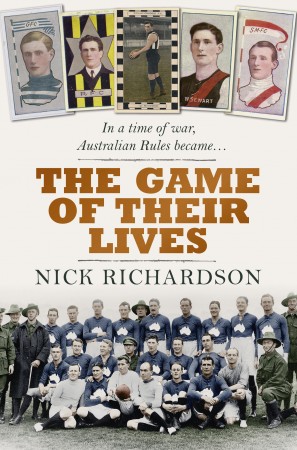The Game of their Lives
July 5, 2016
ALMOST a century ago, some of Victoria’s finest footballers took time out from their military training to take part in a unique demonstration of the game they loved.
The match was dubbed the Pioneer Exhibition Game, and it was played at London’s Queens Club, a venue now known for its tennis competitions. Back then though it was the scene for what was regarded at the first international match of Australian Rules football.
 Yet for all its novelty, there has been precious little time spent on how the game came to be played, who were the guiding lights behind the match and just how important sport, and particularly football, was to the men in uniform. Now, for the first time, the story can be told.
Yet for all its novelty, there has been precious little time spent on how the game came to be played, who were the guiding lights behind the match and just how important sport, and particularly football, was to the men in uniform. Now, for the first time, the story can be told.
It began with three men – an Australian general, an Olympic swimmer and a Richmond footballer. Together, they created the match that would draw more than 5000 people to the Queens Club, many of them Diggers who had found a way to get leave to see footy for the first time since they had left home.
The idea for the game came from Richmond ruckman Hughie James, who was serving with the 3rd Pioneers. The plan was hatched one cool evening when the Diggers were undergoing training in England, before leaving for the Western Front. Once legendary Australian general Sir John Monash heard the idea he instantly backed it. Monash had always believed in the power of sport to boost morale and keep soldiers fit for war. His 3rd Division, which included James’ Pioneers, was cooling its heels in England. There needed to be something to concentrate the minds of his men while they waited for the signal to cross the Channel.
Monash turned to Olympic swimmer Frank Beaurepaire, who was attached to the YMCA in England, to organise the match. Beaurepaire was well-known to Monash: he had delivered a number of recreations for Monash’s troops, including boxing tournaments, a cinema behind the lines, and even a musical troupe. But this game would prove a lasting legacy.
The teams were drawn from the 3rd Division and what was called the Training Units, which was a selection of the soldiers who delivered training to the rest of the AIF at Salisbury. Together, the teams represented every football state, and included some extraordinarily talented men who had forsaken footy for their national duty – South Melbourne’s Bruce Sloss and Carl Willis, St Kilda’s Percy Jory, Collingwood’s Dan Minogue, Richmond’s James and Geelong’s Billy Orchard were among them.
The match was held on October 28, 1916, the same day as the first conscription referendum took place in Australia. The rich irony behind this coincidence was that sportsmen – and particularly footballers – were subjected to a loud campaign to give up playing and enlist.
Just how bitter and divisive that campaign became has been one of hidden stories of World War I. Footballers were reviled in some quarters because they took money to play. Spectators who paid to watch them were damned for supporting the game. But for those footballers who went to war – and those who played in the Exhibition match – nothing would be the same again.
For the full story behind the Pioneer Exhibition match, see The Game of Their Lives by Nick Richardson, published by Macmillan, RRP $34.99, available now.





